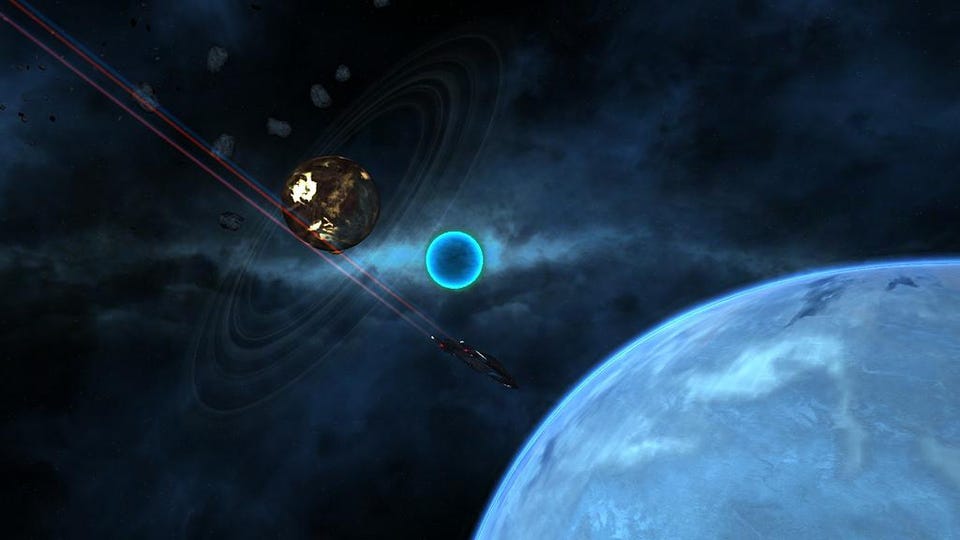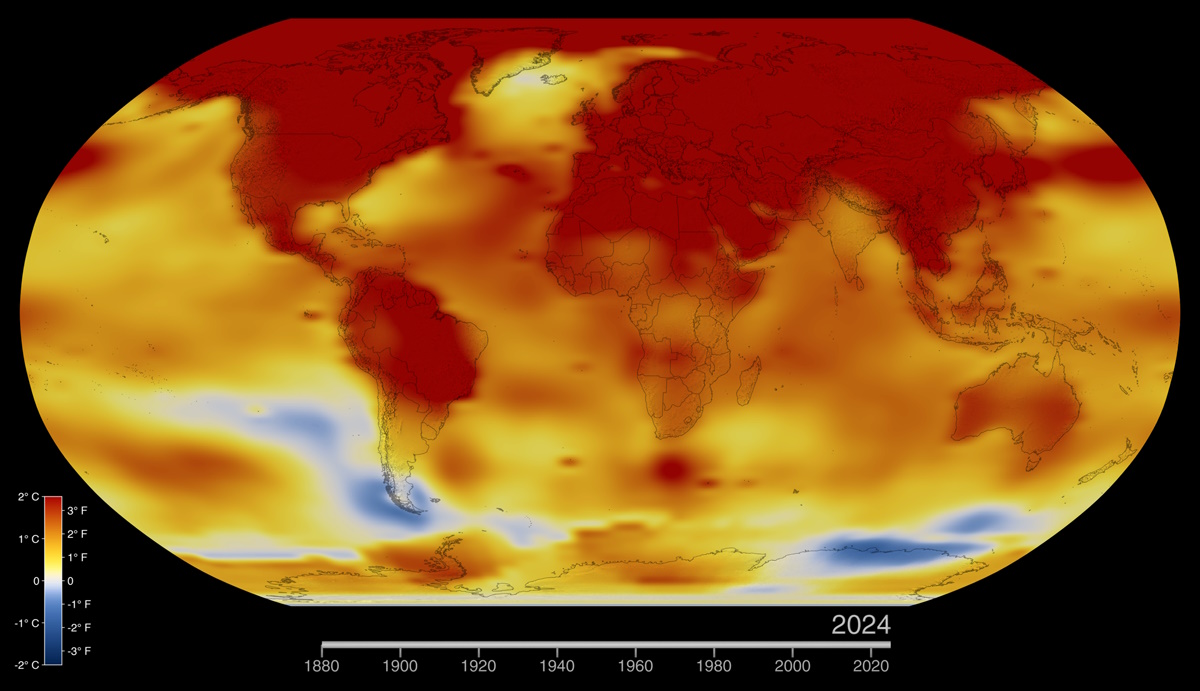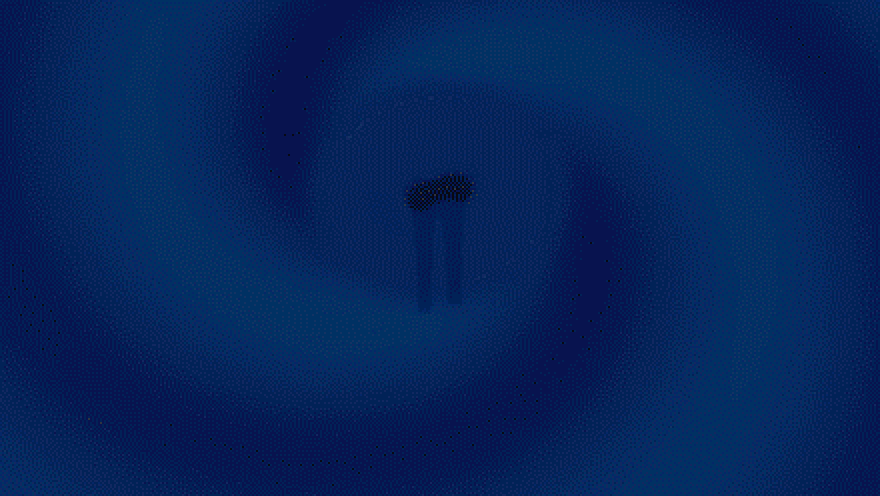Throwback Thursday: The Cosmic Chronicle of Carbon-14
The most common source for radioactive dating depends on our Universe being active.
“Life exists in the universe only because the carbon atom possesses certain exceptional properties.” –James Jeans
Here on Earth, every living thing is based around four fundamental, elemental building blocks of life: hydrogen, oxygen, nitrogen and, perhaps most importantly, carbon.
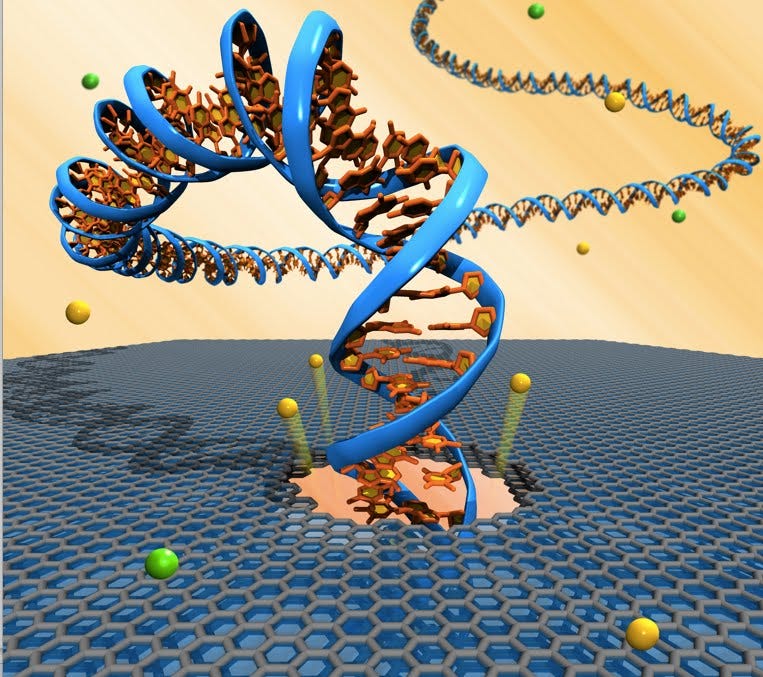
From diamonds to nanotubes to DNA, carbon is indispensable for constructing practically all of the most intricate structures we know of. Most of the carbon in our world comes from long-dead stars, in the form of Carbon-12: carbon atoms containing six neutrons in their nucleus.
About 1.1% of all carbon is Carbon-13, with one extra neutron. Although that form of carbon is also stable, it’s formed much less frequently in stars, and so it isn’t surprising that Carbon-12 is the dominant form of carbon not only on Earth, but everywhere we look in the Universe.
But there is another form of carbon that, while not at all abundant, is definitely worth talking about.
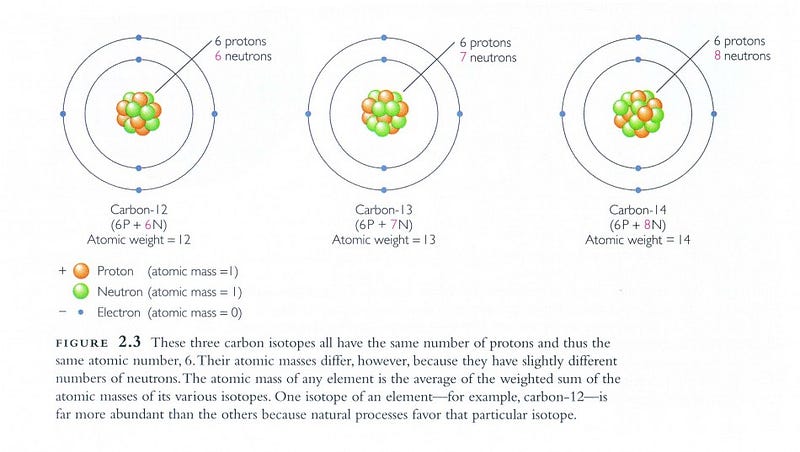
Carbon-14, or a carbon atom with eight neutrons in its nucleus, is unstable, and is so rare that only one-in-a-trillion carbon atoms are Carbon-14. With a half-life of just over 5,700 years, any Carbon-14 atoms that were created in stars, billions of years ago, have long since decayed away into nitrogen atoms.
When elements contain the wrong number of neutrons for the number of protons in their nucleus, they typically decay by one of two methods: either alpha decay, where they emit a Helium-4 nucleus (two protons and two neutrons), or they beta decay, where one of their neutrons transforms into a proton by emitting an electron (and an antineutrino). Although there are variations and exceptions, if you have too many neutrons, you’re likely to undergo beta decay, and that’s exactly what Carbon-14 does.
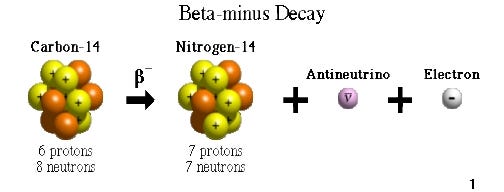
But considering how many carbon atoms there are here on Earth, saying that one-in-a-trillion of them is in the form of Carbon-14 adds up to a tremendous number of atoms! In fact, there are small, but not quite negligible amounts of carbon-14 present in all the organic life that we know, including in our own bodies.
The way it gets here is, literally, cosmic.
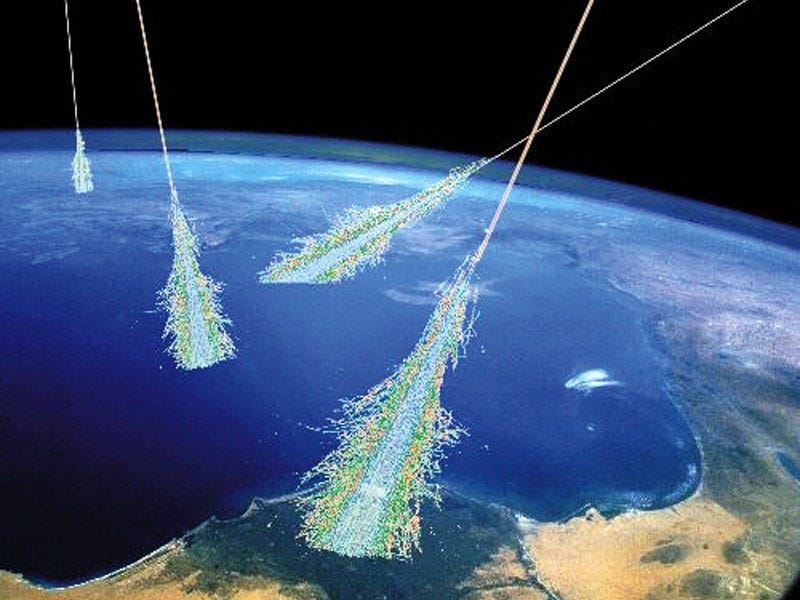
From across the galaxy and across the Universe, from stars (including our Sun), pulsars, black holes and more, space is flooded with high-energy particles known as cosmic rays. Most frequently, cosmic rays are protons, but a handful are heavier ions and a few are even humble electrons.
And if you think that what goes on in the center of the Sun is energetic, you haven’t seen anything until you look at the energy spectrum of cosmic rays.
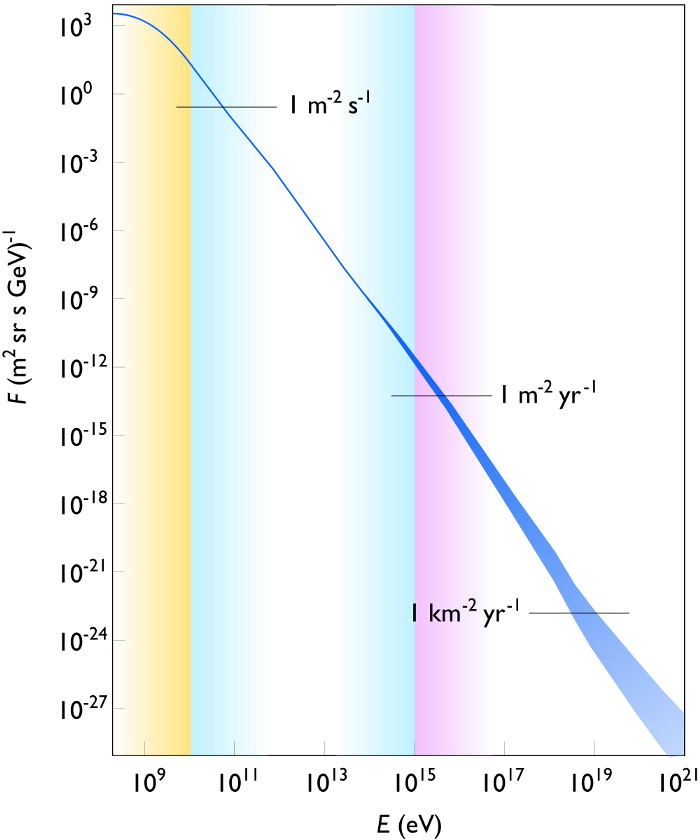
While particles from the Sun are capped at energies of a few MeV (~10^6 electron-Volts), cosmic rays routinely reach energies in the TeV range (~10^12 eV, the same as what we produce at the Large Hadron Collider, the most powerful accelerator in the work) and well beyond, up to a maximum of 4-or-5 × 10^19 eV.
The particles normally emitted from the Sun aren’t typically the ones that create Carbon-14, but the ones from these higher energy sources — the ones at energies of ~10^10 eV and up — can create tremendous nuclear cascades the instant they interact with the upper atmosphere.
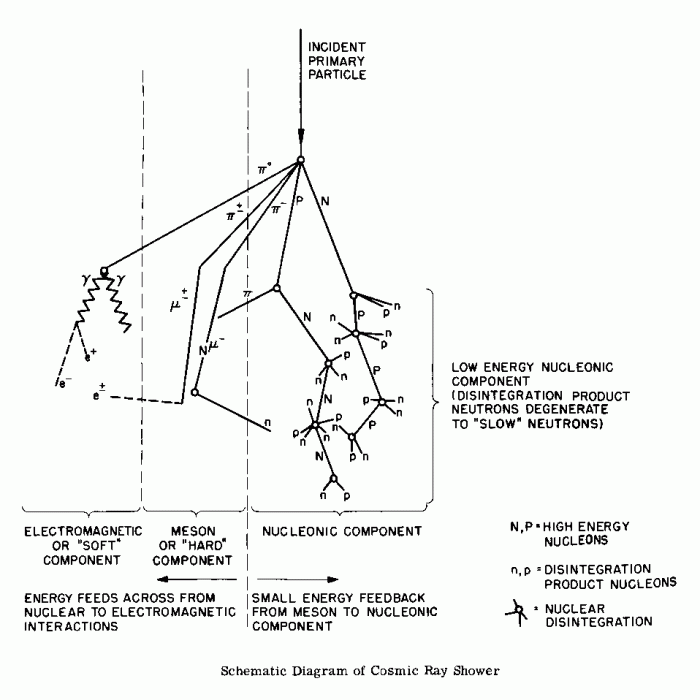
Among the myriad of particles — stable, unstable, and quasi-stable — that get created in these cascading showers of subatomic particles, the humble (but all-important) free neutron is produced in great abundance. The reason neutrons are so important is because our atmosphere is 78% nitrogen, which you may remember as the thing that carbon-14 decays into.
Well, if carbon-14 can decay into nitrogen-14 and other stuff, then we can create carbon-14 by combining nitrogen-14 with the proper stuff. In this case, that happens to be a neutron, which allows the following process to occur:
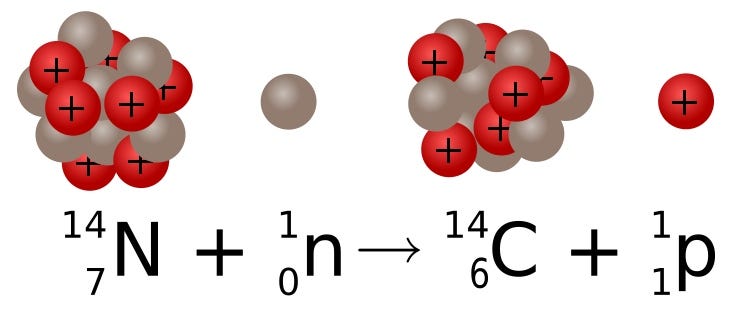
Once you create Carbon-14, it behaves just like any other atom of carbon, readily forming CO2 (a.k.a., carbon dioxide) and mixing throughout the atmosphere and oceans, easily making its way into living organisms and reaching a well-understood equilibrium. As far as we can tell, the levels of Carbon-14 throughout the world have remained roughly constant throughout the past few millennia. During their lifetimes, all carbon-based organisms absorb Carbon-12, 13 and 14 in direct proportion to their atmospheric concentrations, something that’s consistently true over all stages of life for plants, animals, fungi, and all other living creatures large and small.
However, when an organism dies, it no longer uptakes any new carbon, and the old Carbon-14 atoms in their bodies decay. We can measure how long ago it became deceased by measuring the ratio of Carbon-14-to-Carbon-12 in any deceased organism and comparing it to the naturally occurring ratio.
The only major fluctuation we know of occurred when we began detonating nuclear weapons in the open air, back in the mid-20th Century. If you ever wondered why nuclear tests are now performed underground, the pollution of the atmosphere with radioactive particles is one major reason why.
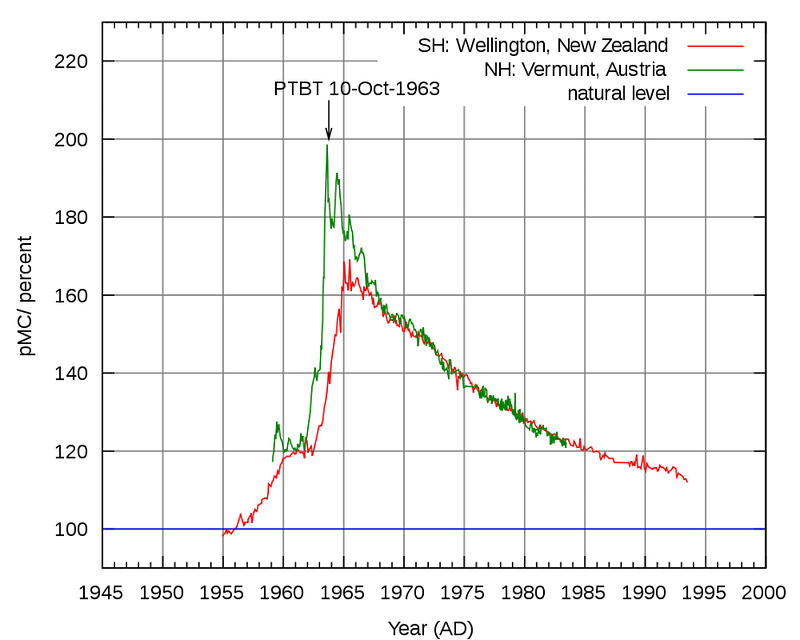
For a long time, it was presumed that only a significant nuclear reaction like this would be the cause of a Carbon-14 spike. But much to our surprise, just a couple of years ago, a team of scientists released a paper showing a big, short-lived spike in Carbon-14 levels way back in the 8th Century!
By looking at the tree rings of ancient Japanese Cedars, you can see a rise in the concentration of Carbon-14 that starts in the 770s, peaks in the 780s and then falls off.
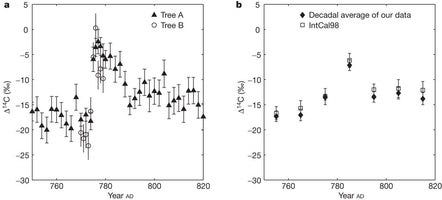
What does this correspond to, in terms of creating this Carbon-14? There must have either been a nearby source of high-energy particles or an abundance of recently enriched Carbon that made its way to Earth. But most of the candidate culprits you’d think of at first are ruled out.
- A supernova in our galaxy could do it, but with the advent of modern infrared, radio and X-ray telescopes, we’ve identified all the supernova remnants in our neck of the galaxy going back more than 2,000 years. There were no nearby supernovae that happened at that time, so that explanation is out.
- An irradiated comet — considering how much carbon they contain — could have carried enriched Carbon-14 to Earth along with its normal amount. It would have taken only about 18 additional kilograms of Carbon-14 to explain this spike, but that would require a comet nearly 100 kilometers in diameter, larger than the strike that wiped out the dinosaurs. So that’s out, too.
- There’s also no evidence of an unusually large solar flare or any other bizarre solar activity, although a superflare — which occurs every few thousand years from Sun-like stars — could be the culprit, in theory.
The closest we have is from the Anglo-Saxon Chronicle dating back to 774, which states:

Could a red crucifix in the sky be some sort of astronomical phenomenon that emitted an intense burst of cosmic rays? A nearby supernova imposter, maybe? A flaring or erupting black hole?
The possibilities are fascinating, but all we know, at this point, is that the data very clearly indicate that there was a real spike in Carbon-14 concentration in the atmosphere around that time. As that isotope (along with all carbon) was sucked up by biological processes, the atmospheric concentration returned to baseline in a mere matter of decades.
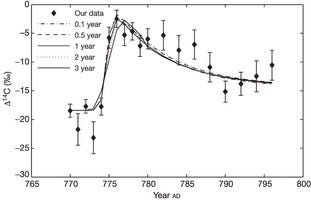
Now, since we’ve been watching the skies, we’ve never seen an increase in cosmic radiation levels that could cause a phenomenon like this, but — to be fair — it’s only recently that our sophistication in measuring the Carbon-14 levels in old tree rings like this has allowed us to test for Carbon-14 spikes like this.
So how are we going to learn more about this in the future? Looks like we’re going to have to unearth more old trees that can be radiocarbon-dated back to these years, and see whether they have elevated levels of carbon-14 in them. If they don’t, then it’s conceivable that these trees are just flukes, or that there was a mistake done in the analysis. But that doesn’t seem likely; there is data from North American and European trees — in addition to Japanese trees — that this is consistent with!
There was very likely an extremely large increase in cosmic radiation over a very short period of time, the likes of which we’ve never seen or recorded, until now. But what caused it, and when will it happen again?
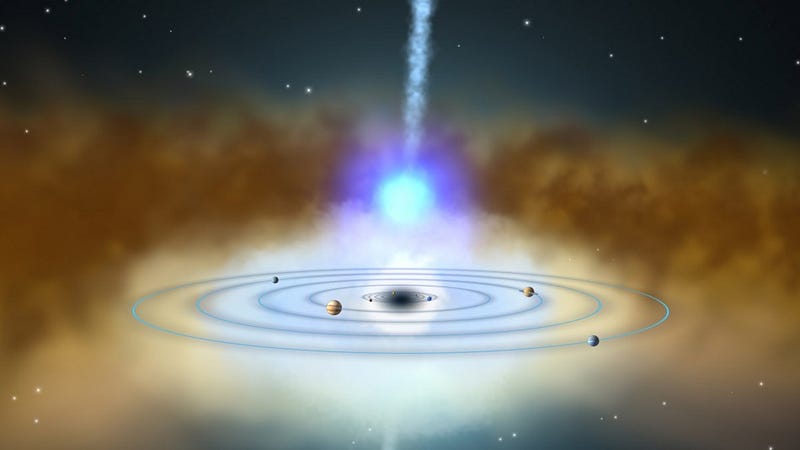
Sometimes, that’s the way it goes with science: the more we learn and the more we come to understand, the greater the number of unanswered questions that arise. We know where Carbon-14 comes from, how it’s made, and we understand that it requires a cosmically active, external Universe beyond our Solar System to continuously regenerate our supply here on Earth.
But as far as a great, natural spike in its abundance over a thousand years ago? We’ll very likely have to wait for a little cosmic luck — or increase our cosmic sight to other star systems — for an answer to this mystery!
Enjoyed this? Leave a comment at the Starts With A Bang forum on Scienceblogs.
